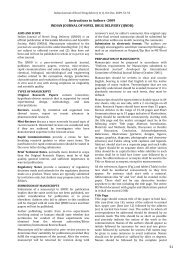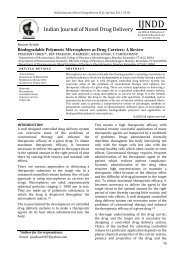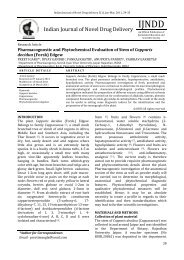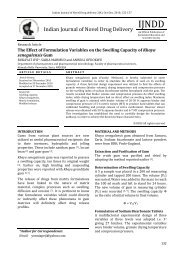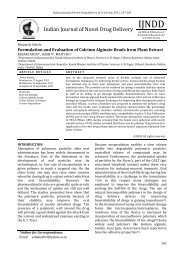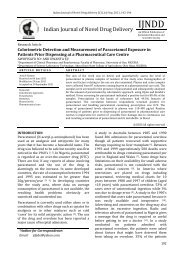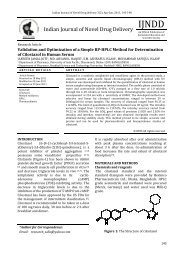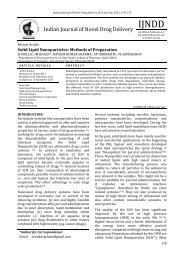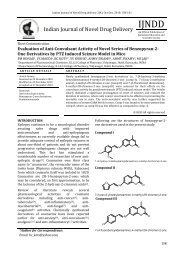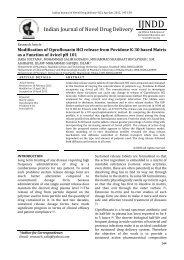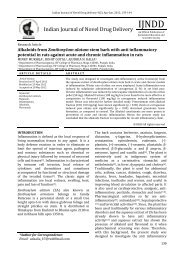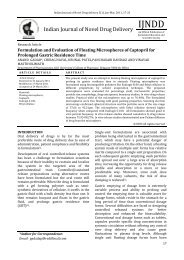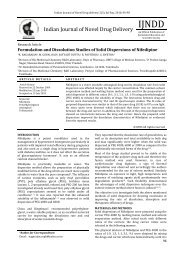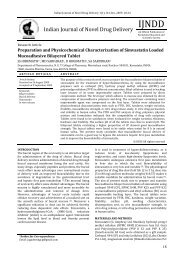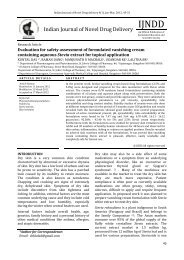Mucoadhesive Polymers - Indian Journal of Novel Drug Delivery
Mucoadhesive Polymers - Indian Journal of Novel Drug Delivery
Mucoadhesive Polymers - Indian Journal of Novel Drug Delivery
Create successful ePaper yourself
Turn your PDF publications into a flip-book with our unique Google optimized e-Paper software.
Swamy NGN et al / <strong>Indian</strong> <strong>Journal</strong> <strong>of</strong> <strong>Novel</strong> <strong>Drug</strong> <strong>Delivery</strong> 4(1), Jan-Mar, 2012, 2-16<br />
Table 2: Summary <strong>of</strong> some nasal drug delivery studies where cellulose derivatives were employed<br />
<strong>Mucoadhesive</strong> polymer <strong>Drug</strong>s Dosage<br />
forms<br />
Abs. BA (%)<br />
Animal<br />
species<br />
Reference<br />
EC FD-4 Powder 38.0 ± 3.8 Rats 95<br />
MCC, pH 5.95 Ketorolac tromethamine Spray 90.77 Rabbits 45<br />
MCC Insulin Spray 1.9 Rabbits 96<br />
MCC Cyanocobalamine Powder 25.0 Rabbits 97<br />
MCC Glucagon Powder - Human 98<br />
MCC/HPC Leuprolide Powder 34.9 Rabbits 46<br />
HPC Dopamine Liquid 25.0 Dogs 48<br />
HPMC/sulfobutylether-βcyclodextrin<br />
Midazolam Spray 73 Humans 99<br />
HPMC Cipr<strong>of</strong>loxacin Gel 40.21 ± 6.41 Rabbits 47<br />
MC Cipr<strong>of</strong>loxacin Gel 18.2 ± 4.8 Rabbits 47<br />
MC/Tween 80 Cipr<strong>of</strong>loxacin Gel 22.3 ± 5.5 Rabbits 47<br />
Table 3: Summary <strong>of</strong> some nasal drug delivery studies where polyacrylates were employed<br />
<strong>Mucoadhesive</strong> polymer <strong>Drug</strong>s Dosage<br />
forms<br />
BA (%)<br />
Carbopol 971P Apomorphine Powder 99.8 ±9.7 (rel vs<br />
SC)<br />
Polycarbophil Apomorphine Powder 105 ± 8.6 (rel vs<br />
SC)<br />
Carbopol 934P<br />
Flouresce<br />
inisothiocyanate<br />
Animal<br />
species<br />
Rabbits 56<br />
Rabbits 56<br />
Powder 33 (abs) Rabbits 100<br />
Carbopol 981P Metoclopramide solution 17.48 (abs) Sheeps 53<br />
Carbopol<br />
981P/HPC/Poloxamer 407<br />
Metoclopramide<br />
hydrochloride<br />
Gel 51.0 (abs) Rabbits 43<br />
Carbopol 974P/DDWM Insulin Powder 14.4 ± 3.5 (abs) Rabbits 57<br />
Gelatin/Polyacrylic<br />
microspheres<br />
Oxprenolol Powder - Rats 101<br />
References<br />
Abs: absolute, BA: Bioavailability, DDWM: drum-dried waxy maize starch, DSM: degradable starch microspheres, rel: relative,<br />
SC: subcutaneous injection<br />
Chitosan and its derivatives have been shown to<br />
be active in enhancing the intranasal drug<br />
absorption because <strong>of</strong> their excellent<br />
mucoadhesive properties. It is also confirmed<br />
that coating micro- and nanoparticulates with<br />
chitosan could improve drug adsorption to<br />
mucosal surfaces [72] . Besides their hydration in<br />
the nasal cavity, the interaction <strong>of</strong> the positively<br />
charged amino group with the negatively<br />
charged sites on the mucosa surface also<br />
contributes to their mucoadhesion [69] . Soane et<br />
al. [73] have reported that chitosan microspheres<br />
and solutions revealed a three and eightfold<br />
longer clearance half-lives compared with<br />
sodium pertechnetate labelled solution in sheep<br />
nasal cavity, respectively. In addition, many<br />
studies have proved that chitosan and its<br />
derivatives could transiently open the tight<br />
junctions between the cells and lead to the<br />
paracellular transport <strong>of</strong> drugs [74, 75] . Table 5<br />
summarizes the recent nasal drug delivery<br />
studies where chitosan derivatives were<br />
employed as absorption enhancers.<br />
9



